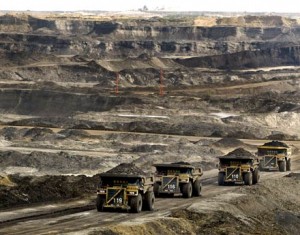– People Who Live Downwind Of Alberta’s Oil And Tar Sands Operations Are Getting Blood Cancer (Climate Progress, Oct 28, 2013):
A new study has found that levels of air pollution downwind of the largest tar sands, oil and gas producing region in Canada rival levels found in the world’s most polluted cities. And that pollution isn’t just dirtying the air — it also could be tied increased incidence of blood cancers in men that live in the area.The study, published last week by researchers from University of California Irvine and the University of Michigan, found levels of carcinogenic air pollutants 1,3-butadiene and benzene spiked in the Fort Saskatchewan area, which is downwind of the oil and tar sands-rich “Industrial Heartland” of Alberta. Airborne levels of 1,3-butadiene were 322 times greater downwind of the Industrial Heartland — which houses more than 40 major chemical, petrochemical and oil and gas facilities — than upwind, while downwind levels of benzene were 51 times greater. Levels of some volatile organic compounds — which, depending on the compound, have been linked to liver, kidney and central nervous system damage as well as cancer — were 6,000 times higher than normal. The area saw concentrations of some chemicals that were higher than levels in Mexico City during the 1990s, when it was the most polluted city on the planet.
“These levels, found over a broad area, are clearly associated with industrial emissions,” said Stuart Batterman,” one of the study’s co-authors. “They also are evidence of major regulatory gaps in monitoring and controlling such emissions and in public health surveillance.”
The high levels of dangerous pollutants may be harming the health of residents downwind of the industrial center. The study, which examined ten years of health records, found incidence of leukemia and non-Hodgkin’s lymphoma in men was higher in communities closest to the sources of pollution than in the surrounding counties. Though the study could not definitively link the uptick in cancer incidence to the increased pollution, the researchers said it was enough to call for reductions in the emissions from the industrial center.
“We’re seeing elevated levels of carcinogens and other gases in the same area where we’re seeing excess cancers known to be caused by these chemicals,” said lead author Isobel Simpson. “Our main point is that it would be good to proactively lower these emissions of known carcinogens. You can study it and study it, but at some point you just have to say, ‘Let’s reduce it.’ ”
The study comes just weeks after a World Health Organization agency classified air pollution as a carcinogen for the first time. And it’s not the first study to find a link between tar sands and other industrial energy extraction and increased levels of dangerous pollution. A 2012 study found pollution levels in lakes around tar sands operations increased significantly after tar sands development began, and another 2012 study found emissions of certain gases from tar sands operations rivaled those of major power plants. In 2009, Alberta health officials confirmed that there were higher than usual rates of cancer in a small aboriginal village downwind of Alberta’s major tar sands operation, and the oil town of Port Arthur, Texas — the last stop of the Keystone XL’s proposed path — sees cancer rates that are 15 percent higher than the rest of Texas.
The latest study’s findings point to the need for better monitoring of Alberta’s tar sands’ pollution. Right now, the tar sands’ emissions are monitored by the Wood Buffalo Environmental Association, a group that’s funded by Canada’s oil and gas industry. And according to the study, energy operations in Alberta aren’t disclosing all their emissions — high levels of one carcinogen documented by the researchers could only have come from one facility, but the researchers found that company hadn’t reported any emissions of the chemical.
